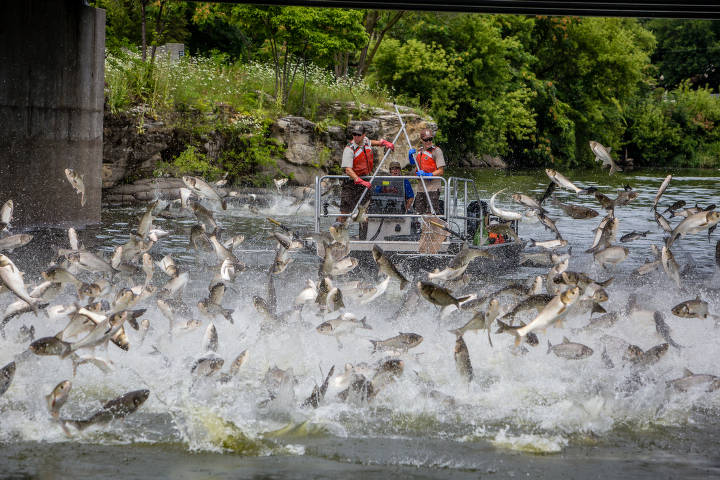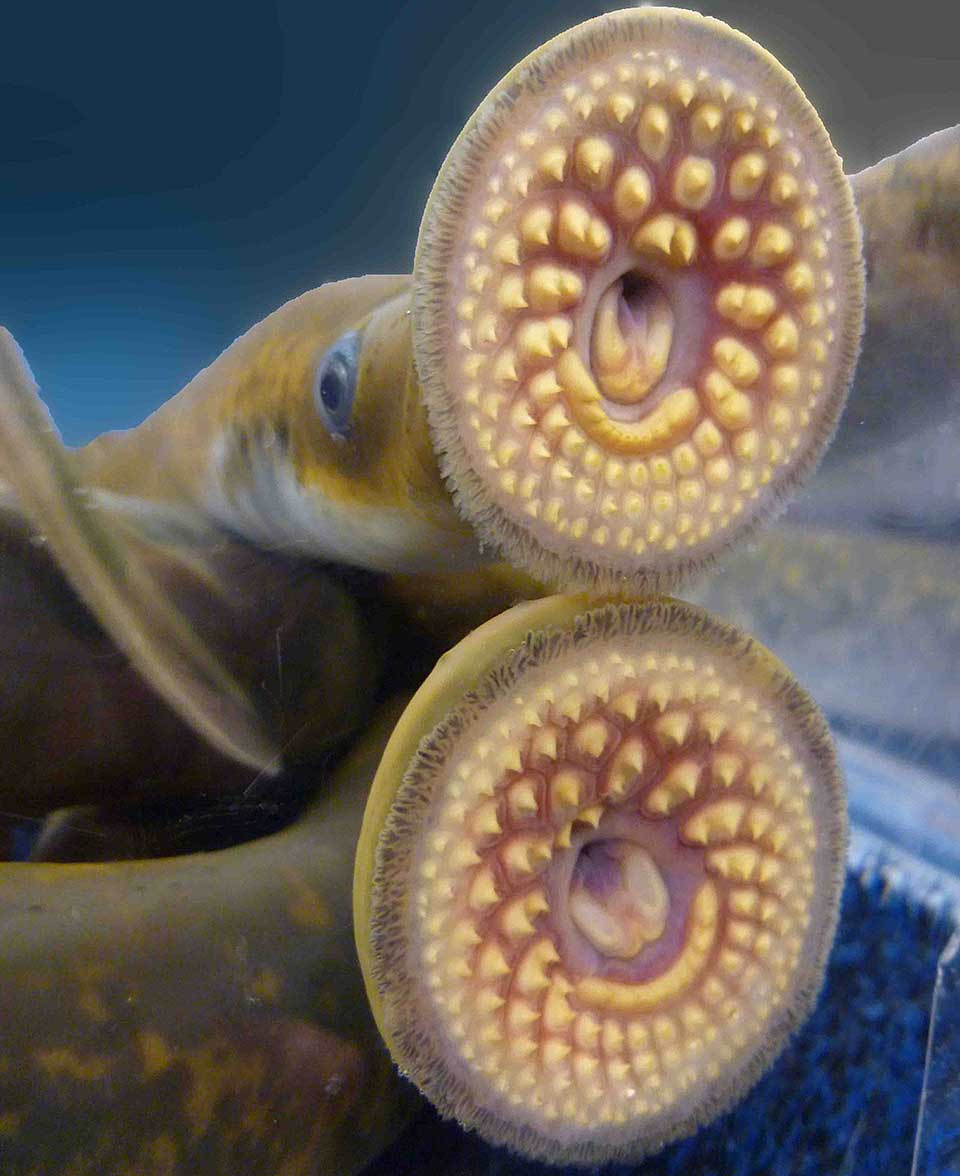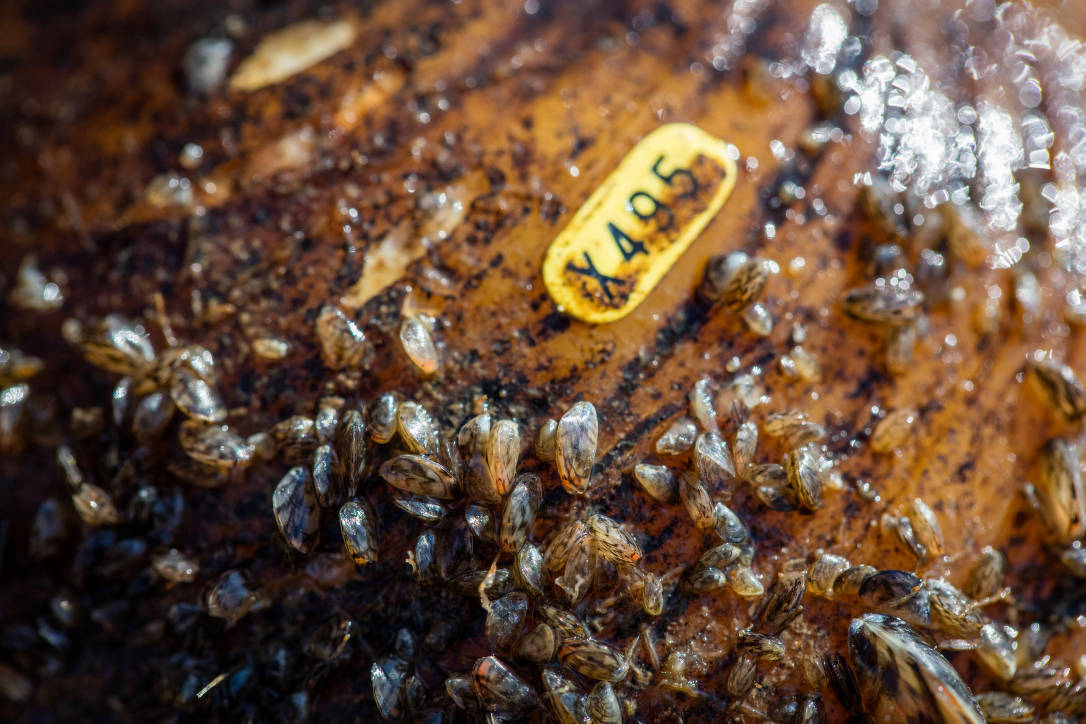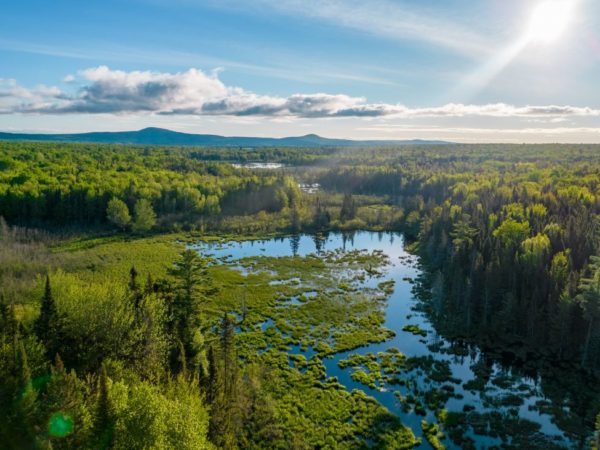
Lake Erie covers about 9,900 square miles and stretches 240 miles from southwest to northeast with an average depth of 62 feet. It borders four states and the province of Ontario. About 12 million people live in the watershed, including 17 major metropolitan areas. More than 10 million people rely on the lake as a source of drinking water.
The lake has seen some tough times over the last 150 years. As the shallowest and warmest of the Great Lakes, it contains just two percent of their total water volume yet hosts 50 percent of their biomass — all living organisms like fish, plankton, mollusks, and other creatures. This treasure of natural resources has caused trouble at the hands of humans.
2,000 B.C. Lake Erie, as we know it today, is formed
“It really started as the glacial ice was retreating about 18,000 years ago,” said Andy Nash, an Ohio Department of Natural Resources geologist. “There was a series of older pro-glacial lakes during the Ice Age. The Great Black Swamp was actually the lakebed for some of these lakes.”
As glaciers retreated from what is now Ohio back into what is now Canada, the formations they left behind created Lake Erie, which is as shallow a few feet in the west and as deep as 210 feet in the east.
2,000 B.C. – 1700 A.D. Native Americans live, hunt and fish on the lake
Historical records show that North America’s first inhabitants lived on Lake Erie for thousands of years before Europeans arrived. Their daily lives included a host of fishing techniques, including nets and weirs, as well as spearfishing. Fish were often dried, smoked or salted and used in trading with other Native American tribes. The lake’s early residents traveled around the lake and its tributaries, as well as to other Great Lakes, in birchbark canoes.
1669 French explorer Adrien Jolliet first European to visit Lake Erie
Adrien Jolliet was dispatched by the Governor in Montreal to locate a copper mine somewhere on Lake Superior and then find a convenient route for loaded ships to return. Instead, he met an Iroquois Indian, and the pair subsequently paddled the length of Lake Huron in a canoe through Lake St. Clair and emerged on Lake Erie. This was the first recorded European “discovery” of Lake Erie.
1850 Population growth spurs intense pollution
By the mid-nineteenth century, Europeans had migrated west from the Atlantic coast and established dozens of towns and some major metropolitan areas. Railways began encircling the lake, and the industrial age — which would plague the lake for a century-plus — had arrived. By the turn of the century hundreds of oil refineries and thousands of factories dumped toxic waste into the lake and its tributaries while communities poured waste and sewage into it.
1879 Common carp imported from Europe for food
This European native was introduced to Lake Erie and other inland waters, intended to serve as a food source. Unfortunately, its habits have consistently degraded the ecosystem where they most often thrive: shallow waters, including rivers and wetlands. Their habit of rooting across bottoms in search of food tends to create turbid water conditions often limiting the reproduction of many other fish species. It now resides in all the Great Lakes states and tributaries, as well as most of the U.S.
1909 International Joint Commission established
The Boundary Waters Treaty of 1909 has helped the U.S. and Canada navigate many issues related to the Great Lakes and shared streams, including water diversions, invasive species, pollution, water levels, and navigation problems. Three commissioners from each nation help guide water managers with common concerns. As early as 1997, the IJC began looking toward the future in planning for climate change.
1930 Sea lamprey established

Sea Lampreys. (Provided by USFWS)
Native to the Atlantic, sea lampreys were observed in Lake Ontario in the early 1800s, though confined by Niagara Falls. But by the 1900s, they had migrated through the Welland Canal into Lake Erie and the other Great Lakes. This long, eel-like parasitic fish has a circular mouth with more than a hundred sharp, bony teeth. It attaches itself to any large fish, boring into flesh and sucking nutrients from the fish, often killing its host. Many lampreys can latch onto a single large fish, and at one time, large lake trout pulled out of commercial fishing nets were often described as “Swiss cheese” after falling victim to multiple lampreys.
1954 Great Lakes Fishery Commission (GLFC) established
The creation of this bi-national organization was largely a result of the sea lampreys’ devastation of fish in the Great Lakes. The GLFC’s mission is to foster cooperative management of fisheries resources between the U.S. and Canada. The downward spiral of the commercial fishing industry was a driving force in its creation. Currently the U.S., Canada and tribal nations help guide the GLFC mission.
1958 Blue pike population plummets, disappears
Blue pike had the appearance of walleye, yet smaller with larger eyes and a blue-gray hue. In 1885 records show 3.1 million pounds were harvested, swelling to 26 million pounds in the early 1950s. By 1959 the catch had dwindled to 89,000 pounds. In 1964, fish dealers sold just 200 pounds.
A combination of factors doomed the fish, considered by some scientists to be a sub-species of walleye: overfishing and a lake filled with toxic pollution. Once the population had been reduced to near zero, interbreeding with walleye was the end of blue pike. The last known blue pike was caught in 1962 by a Conneaut, Ohio, barber who tucked it away in a freezer for 52 years until he donated it to The University of Toledo for study.
1960 Most commercial fisheries have collapsed
Commercial fishing on Lake Erie, which provided food for millions of people, had been on the decline for decades. When whitefish, sturgeon, herring, and lake trout declined in population, commercial fishermen targeted other species. Any species they could earn a living on would serve the purpose and, at one time or another, included catfish, suckers, muskellunge, mullet, bowfin, sauger, smelt, white perch, white bass, burbot, and American eel, among others. By 1960, Lake Erie had little to offer. And then the greatest thing happened to Lake Erie: the Cuyahoga River caught on fire.
1969 Cuyahoga River burns again
The Cuyahoga River burned in 1969, as did other Lake Erie tributaries over the years. And it wasn’t the first time. Most rivers that burned had multiple fires. But the magic of the Cuyahoga’s most recent fire was that it occurred during the same news cycle as the Apollo 11 returning from the moon and Senator Ted Kennedy’s infamous Chappaquiddick crash. Time Magazine had begun dedicating one article per issue on environmental topics, and the August 1, 1969 issue was the Cuyahoga River’s time to garner national attention in the most-sold issue ever.
It was literally a watershed moment for Lake Erie. Some consider it the beginning of the modern conservation movement. Its burning was followed quickly by other wins for Lake Erie and the environment as a whole.
1970 Environmental Protection Agency established
Responding to public outcry and mounting sentiment to protect natural resources, President Nixon presented Congress with a wide-ranging proposal enabling the federal government to enforce environmental regulations. It was passed into law, thus creating the United States Environmental Protection Agency, a powerful body tasked with ending unrestrained pollution. Congress appropriated about $1.4 billion for the EPA’s first-year budget. A year later, Canada responded likewise, creating the predecessor of what is now Environment and Climate Change Canada.
1970 First Earth Day celebrated
The year after the Cuyahoga’s most famous fire, Wisconsin Sen. Gaylord Nelson spearheaded efforts to organize the very first Earth Day on April 22. With the aid of millions of seasoned protesters focusing their efforts on environmental issues, Nelson and like-minded citizens and civic leaders urged people to unite on behalf of the planet.
As the first Earth Day wound down, news anchor Walter Cronkite reported, “A unique day is ending in American history, a day set aside for a nationwide outpouring of man seeking survival, Earth Day. A day dedicated to enlisting all the citizens of a bountiful country in common cause of saving life from the deadly by-products of that bounty, the fouled skies, the filthy waters, the littered earth.”
1972 Clean Water Act (CWA) & Great Lakes Water Quality Agreement (GLWQA) created
The CWA and GLWQA were both enacted in the shadow of the Cuyahoga River fire and were meant to reign in pollution on Lake Erie and its tributaries and improve water quality. The former aims to regulate discharges of all types into surface waters, while the latter aims to improve, restore and protect all Great Lakes waters.
“Between 1969 and 1972 incredible things were happening, major moves for the country,” said Jeff Reutter, former director of Ohio State University’s Sea Grant program. “The agreement allowed scientists to come together and target a 60 percent reduction in phosphorous, which at that time was coming mostly from poor sewage treatment, not farm animals.”
1976 Great Lakes Fishery Commission establishes quota system
Utilizing scientific data on yellow perch and walleye populations, the GLFC began implementing annual allotments on how many of each species could be harvested by each Lake Erie stakeholder. Between Ontario, Michigan, Ohio, Pennsylvania, and New York, fisheries managers set rules to ensure that overfishing, whether recreationally or commercially, never happened again.
“It was incredibly pivotal,” Reutter said. “The Great Lakes Water Quality Agreement improved the ecosystem but the GLFC and its quota system for perch and walleye in my mind was equally important in that it prevented the overharvest of fish, and up to that point we had overharvested one species or another, like blue pike.”
1988-89 Zebra & quagga mussels discovered

Zebra mussels colonizing on the shell of a native mussel. (Provided by USFWS)
In a two-year period, both mussels, native to the Caspian and Black seas, were found in Lake Erie. The small mussels colonize rapidly and attach to anything and everything, including boat and ship hulls, buoys, rocks, nets, ropes, sea walls, water intakes, and virtually anything else they come into contact with, including each other.
“We literally found the first zebra mussels in Lake Erie in 1988 when we were removing our docks in the fall at Stone Lab. A limnology class from Ohio State University was there and they actually identified them,” said Reutter.
Scientists also discovered the mussels, which now number in the countless billions, have fundamentally changed the food chain in Lake Erie by filtering out plankton, algae and other nutrients from the water. This affects not only the food supply for fish but also brings increased water clarity, which comes with other effects, including warmer water and increased harmful algae production.
“With invasive species, once it’s established you’re not getting it out,” Reutter said. “You could get it out of inland lakes if you really wanted, but you could never do that with systems as large as the Great Lakes.”
1993 First World Water Day celebrated
The United Nations General Assembly designated March 22 as World Water Day. The 2024 theme is Water for Peace. Past World Water Days have focused on water quality, disasters, cities, groundwater, transboundary water, and water waste — among others. The UN’s goal is to bring awareness to the public and influence leaders on crucial water-related issues.
2014 Toledo Water Crisis
In August 2014, Toledo residents were told not to use tap water for several days due to toxins resulting from a harmful algal bloom (HAB) in Lake Erie. The emergency created outrage and also spurred changes to municipal water treatment systems, as well as a renewed focus on ending HABs in the lake. The sometimes toxic blooms are the result of too many nutrients in the water, coming mostly from crop fields and animal farms in the lake’s watersheds.
2024 What’s next — climate change, Asian carp?
What challenges lie ahead for Lake Erie? Climate change and Asian Carp are at the top of the list. In recent years, Lake Erie has had progressively less ice cover each winter, which can affect fish spawning, seiches and possibly algal blooms. And several species of invasive carp appear to be knocking on the Great Lakes’ door in Chicago and northeast Indiana.
“What worries me most right now is that we haven’t taken the necessary steps to reduce nutrient loading from agricultural fields,” Reutter said, referring to the persistence of annual HABs. “But then also we could have a species come in that’s currently not on the radar that we’re not thinking about. It could also be some kind of genetic mutation that occurs in the HABs we’re currently getting that makes those species even more contaminated, prevalent, more dangerous. Who knows?”
Catch more news at Great Lakes Now:
Smart buoys help brace Great Lakes for environmental challenges
Strong winds uncover spectacular features and long-lost structures
Featured image: Staff electrofishing for invasive silver carp one of the Asian carp species threatening the Great Lakes. (Provided by USFWS)
8 Comments
-
It’s there a facility set up to study the conversion of algae into bio fuel?
-
Great article, reminds me of a comment my Dad said, in 1970 I asked him why we didn’t just turn on the tap ? See every spring in Ontario we would divert the water from the bathtub through our raspberry patch , we had large gardens… and he said it’s a shame how our water is so abused , polluted, wasted and one day we’ll pay more for water than gas , kinda funny how true that is , back then we had rain barrels under every eaves trough, something I didn’t see anywhere else
-
Asian carp will be the finishing touch. Humanity can’t even take care of the one planet that we live on.
-
Great read, thank you James
I do have one bit of feedback:
The Haudenosaunee do not appreciate the term Iroquois, it is a derogatory term.
Much appreciated. -
Very nice summary of Lake Erie’s ecosystem history. It included many facts.
-
It was stated that clear water makes the water absorb more heat, wouldn’t cloudy water absorb more heat from the Sun?
-
It’s so sad how many of us really don’t care. Nor try to actually be a part of the ecosystem. Convenience and instant gratification is the “American” way.
We need to do better and stop reproducing for awhile. Focus on ourselves and how to do better for our Earth. -
Well it’s older than that. In Harbor Creek PA just south of Rt 20 and 6 mile creek there is still a complete underground lake from the ice age with fish with no eyes and 2 miles south of the lake on 12 mile creek has fossil sea shells in the shale along with plant life which is about 300 ft higher than the current lake Might look at Interstate 90 as original Lake Erie shore line




